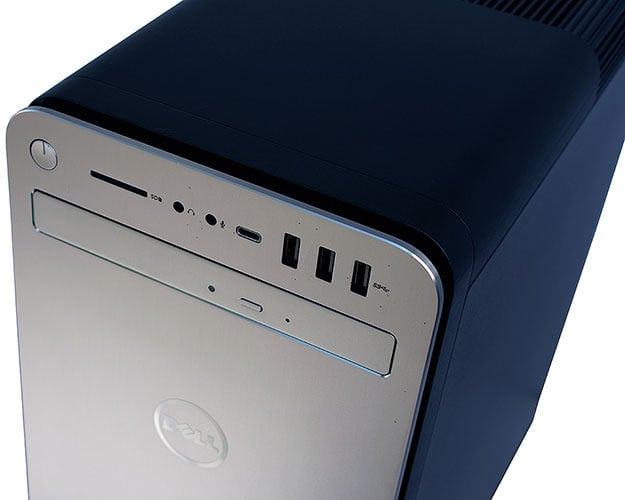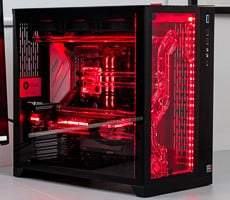Dell XPS Tower Special Edition (8930) Review: A Coffee Lake-Infused Sleeper Rig
While some of the innards are new and more powerful than the previous generation, the chassis that Dell uses for its XPS Tower SE desktops is largely unchanged, save for the connectivity options. That is not a bad thing. It remains an attractive, compact design with a relatively small footprint—the system measures 15.22 (H) x 7.09 (H) x 14.02 (D) inches, and checks in at around 22 pounds.
The XPS Tower SE lacks the angled lines and out-of-this-world aesthetics of Dell's Alienware systems by sticking with a more traditional desktop tower form factor, but is not a boring design—it is more Bruce Wayne than Clark Kent. The silver front panel is made from metal, not plastic, with Dell's logo in the middle and the XPS brand stamped onto the lower left section. Both are also made of metal and protrude ever-so-slightly from the front panel.
A small gap between the front panel and the body of the chassis gives the XPS Tower SE a bit of character, as do the rounded corners. The main section is a matte black, with several grooved lanes carved out along the top and left-side panels for ventilation (and character).
You may have built up a collection of game discs and music CDs over the years, only to have the tech industry give you a wedgie by pushing everything to the cloud, rendering optical drives practically obsolete. But like the character Romney Wordsworth (played by Burgess Meredith) in the Twilight Zone episode "The Obsolete Man," Dell fights back against the societal trend of obsolescence—in this case, Dell invites you kick it old school with a DVD burner. There is also an option to upgrade to a Blu-ray burner, though it is one or the other, as you can't have two optical drives in this thing. Hey, Dell had to draw the line somewhere!
An assortment of modern ports crest the top section, including three USB 3.1 Gen 1 Type-A ports and a USB 3.1 Type-C port. To the left of those are separate microphone and headphone jacks, along with an SD memory card reader and a power button—we are still not at the point where you can turn a PC on by saying, "Hey Dell" or some other wake phrase.
There are seven more USB ports on the back, including three USB 3.0 Gen 1 Type-A ports, a USB 3.1 Type-A port, a USB 3.1 Type-C port, and two USB 2.0 ports. Scattered in and around these ports are more connectivity options consisting of a Killer E2400 GbE LAN port, three audio jacks supporting 5.1-channel audio, and DisplayPort and HDMI outputs (one each), both of which tap into the onboard graphics. If you are running a discrete graphics card, you will have access to additional display outputs.
A handy-dandy handle sits at the top of the chase, along with a security lock slot. The most interesting feature, however, is a pair of release latches. One of these holds the left side panel in place and the other locks the power supply into place, which is attached to an arm swing.
Here is a look at the system with the side panel removed:
At first glance, this looks like a restrictive proprietary design that blocks users from troubleshooting hardware and swapping out components. That quite literally is not the, uh, case (see what we did there?). After unlocking the other latch, the swing arm assembly with the PSU attached lifts up and out of the way, giving full access to the guts of the XPS Tower SE.
One downside to the compact design is there is not much in the way of elbow room. However, Dell did a good job packing high end gear into a relatively small compartment, while still giving users the ability to dive inside and play the part of tech surgeon. Every major component is accessible: CPU, RAM, graphics card, and storage device.
For this particular configuration, Dell went uptown with its parts selection and made use of the motherboard's M.2 slot with a 256GB NVMe SSD, and PCIe 3.0 x16 slot with a GeForce GTX 1070 graphics card. One thing we would change is the capacity of the M.2 SSD, which is the primary storage in this setup. A 256GB SSD can feel restrictive after downloading and installing a few games. There was not much room left on the SSD when we finished loading up our gamut of benchmarks, which includes a several games that consume tens of gigabytes each.
As with the previous generation, the refreshed XPS Tower SE draws power from a 460 watt power supply. It provides enough wattage to feed this configuration with its GeForce GTX 1070 inside, and can also handle a GeForce GTX 1080, which Dell offers as an upgrade option. Beyond that, however, it would not be a good idea to try running a GeForce GTX 1080 Ti or Titan Xp off this PSU—it is rated to deliver up to 225W of graphics power via two 6-pin PCIe connectors, falling a little short of the 250W required by the GeForce GTX 1080 Ti and Titan Xp. Next generation GPUs based on Volta (NVIDIA) and Navi (AMD) could provide upgrade opportunities depending on potential improvements to power efficiency, but in the shorter term, there is a limited GPU upgrade path.
Adding more storage is much easier. Not only are storage devices comparatively power friendly, there are a couple of open bays with available SATA power connectors that Dell thoughtfully dangled within easy reach.











